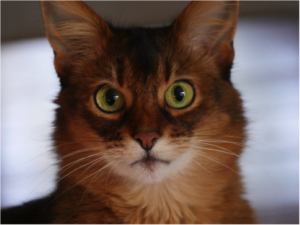
Okay, okay…. a feline version of Paleo.
After all, my cat is (much as we are) identical in most respects to his wild counterparts, none of whom would be caught dead eating Purina Cat Chow or some feline version of “Kibbles and Bits”. And no self-respecting cat born in the wild would be caught dead eating the grains, soy by-products (toxic to cats, by the way) or “colorful vegetables” so many cat foods include as silly ingredients so pet owners can feel ridiculously assured that their cat is getting their perceived “human” dietary requirements met.
First, a bit of background…
Opus is a gorgeous and congenial 16-year-old Somali cat that also happens to be my favorite and most beloved furry companion. From the time I brought him home at four months of age to this very day he has never required veterinary care (he never even goes to the vet); he looks like a show cat, plays like a kitten, is scary smart, endlessly curious and is otherwise delightful in every way. And Opus simply loves “mom’s home cooking”– except for the fact that he only eats raw food (save the occasional tidbit or savory morsel that he might on occasion con us into sharing with him from the dinner plate from time to time). Each and every month I make his food for him. It takes me all of about an hour or less to assemble all of the ingredients and apportion them into small containers that I then stack in the freezer until I need them. He eats essentially the same thing every single day and he wouldn’t have it any other way. Around the house we call his food “kitty crack”, because he seems to snort it up just about as fast as I am able to put it in his dish.
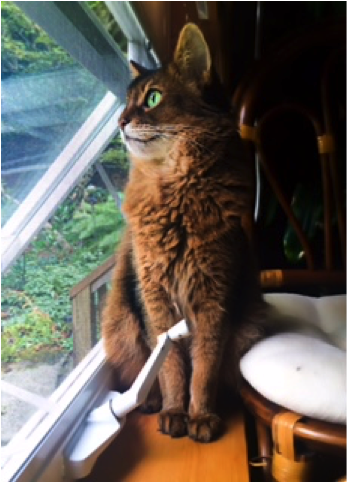
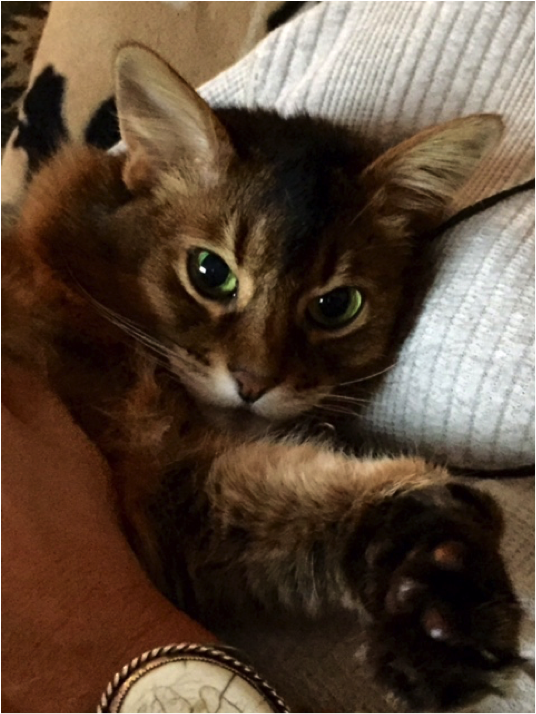
My plan is to see to it that Opus never requires veterinary care in this lifetime and that he maintains his excellent health and disposition into what I hope will be a very old age. I realize that I may be triggering some controversy in admitting that he doesn’t get regular medical checkups, but having done work in veterinary medicine in the past and recognizing the preventative value of quality diet and lifestyle, I prefer to err on the side of staying away from conventional veterinary care unless he absolutely needs it (I personally opt for the same with respect to conventional medical care, myself). Thankfully, he has never needed it. Nor I. Knock on wood.
When Opus first came home as a tiny kitten he was fairly skittish, a bit neurotic and drama-oriented. He needed regular, weekly baths in those days due to an unsightly, oily patch of fur he had on his chest that was regularly recurring–something not uncommon with his breed.
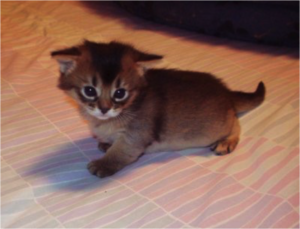
I once had another Somali, named Rusty, that had this very same issue and he required weekly baths for his whole life (I wish I had known then for his sake what I know now for Opus). But whenever I got little Opus into the sink and began using the hand-held sprayer on him, gently soaking him with pleasantly warm water to suds him up, anyone walking by the house on the sidewalk might have thought I was committing feline murder. His ear-splitting wails expressed pure, merciless torture… And I can’t say that I was having a particularly good time either. But once it was all over with, as soon as I got him toweled off, all was forgiven. Treats were offered in contrite compensation (and accepted) and it was all good… Until of course the next time.
I got Opus started on a raw food diet pretty much right away after bringing him home. Within no more than about two months, his oily coat condition went away and he no longer required any bathing–Thank God. Other than a bit of spot cleaning on rare occasions (for reasons best not discussed here), he has not required a bath in 16 years.
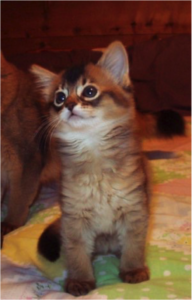
Being the fastidious fellow that he is, he looks perpetually well-groomed… even upon awakening each morning. I’m tempted to resent him for that almost entirely maintenance-free, naturally coiffed beauty he seems to possess, but he is so otherwise adorably delightful that I am quickly able to set aside my jealousies. He is simply a spectacular, ridiculously healthy and lovable fellow. Each day he begs for me to play with him using his favorite feather wand, which he enjoys selecting from the assortment of toys in his cat toy drawer. He has a thing for feathers and I have learned to put those toys away in a drawer when he is done playing with them– lest I find the shredded, colorful remains of exotic-looking feather parts and downy fluff throughout the house later on. NOT fun to vacuum up. Even at age 16 his lightning reflexes are blindingly fast. For an animal that doesn’t belong to a gym or practice yoga poses his physical prowess is truly a marvel to behold.
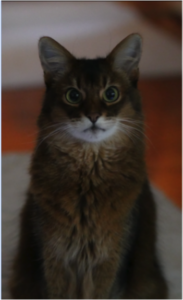
Side story (TOTALLY off-topic, but fun to share): Up until about a month ago, Opus never had any interest whatsoever in catnip…i.e., Kitty ganja. Cat weed. The devil’s lettuce. Apparently, he seemed to be in that minority percentage of cats that have that sober gene that renders the offering of pure, fresh, intoxicating catnip a yawning bore. I tried and tried again over the years to entice him with the delightful debauchery of feline wacky weed–but alas. My cat was square. Given how much fun it is to watch a cat trip out on the stuff I was always pretty bummed out about that. Well, apparently Opus has all of a sudden, inexplicably decided to join the new psychedelic age and now—out of the blue—he absolutely loves it! A late bloomer, apparently.
I had purchased a new scratching post for him from a company online that generously enclosed a small, “2-finger” bag of feline contraband in the packaging as a small “thank you” gift. It was a nice touch, I thought, but I lamented the wasted gesture and, sighing, just set it aside on the desktop. I then set about assembling his spankin’ new scratching post. Suddenly I heard a distinct crinkling sound and looked up to see him actually trying to get into that package. WTF?? Could this be my imagination? –Might he merely be interested in the crinkling sound of the packaging? Or…
I cautiously reached into the plastic packaging to his considerable alert anticipation and placed a pinch of that kitty ganja on the carpeting in front of him… And as if he had been waiting his whole life for that thrilling moment of psychonaut lift-off he immediately gobbled it up and, wild-eyed, begged for more. Wow. Really? Go figure. Opus had at last found “the right stuff”. Perhaps living in Oregon finally got to him… Or maybe he just didn’t want to feel left out of all the fun with the recent change in cannabis laws around here. Perhaps some mysterious epigenetic trigger got pulled and swept that now dormant catnip-indifferent gene under the rug. Maybe he listened to a Terrence McKenna podcast. Whatever his catnip avoidance trip was before, now he’s WAY into it.
My otherwise well behaved, straight-lace cat is officially a stoner.

Perhaps next month we’ll try microdosing his catnip for that extra performance edge (likely enjoyed by many-a Silicon Valley feline)…though it’s hard to imagine him becoming any smarter, more unique or well-adjusted than he already is.
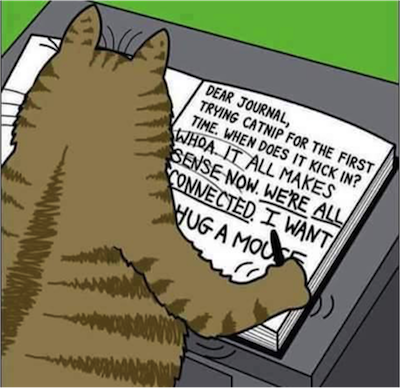
OK… So getting back to the actual point of this article:
For quite a long time now I have thought that I ought to share the secret of Opus’s excellent health with all of you. I don’t buy his food prepackaged in any way and I really do go through the painstaking process of making his food fresh for him each and every month. Am I somehow spoiling him? No way. I am merely 100% committed to his health and wellbeing. I love my cat almost as much as some people love their own children. He gets his share of tough love and he knows his boundaries. I also know that I am not alone in my wholesale love for my furry companion and that too often people’s pets nowadays are falling prey to the same junk food and medical malfeasance we humans are routinely subjected to. –Often with devastating, heart-shattering consequences. I have friends and close family members that have virtually gone broke paying for what might have otherwise been avoidable medical care for their pets, and all too often they are subject to many of the same wholly preventable modern day metabolic ailments and immune vulnerabilities that plague our human healthcare (read: disease management) system.
Figuring out why so many dogs and cats are as unhealthy as they are nowadays isn’t too hard. Apart from the horror stories of what many pet foods coming out of China are tainted with (remember the tragic and lethal melamine debacle?), we are also left to wonder what is meant by “animal byproducts” (ummm, lips and assholes?). Reading labels on pet food cans and bags of dry kibble is not for the faint of heart, and I cannot think of one single brand name that I would recommend as a sole dietary staple for anyone’s beloved pet. So in the spirit of prevention I take just a little bit of extra time every month to safeguard Opus’s health and well-being by feeding him in a manner most in alignment with his evolutionary and genetic heritage. He and I share that aspect of our respective health approaches in common. And we both reap the considerable rewards for it. The alternative nowadays is, well, unthinkable.
Many of my friends have asked for the recipe I put together for him and I am always happy to share it. I know many of you have dogs and cats at home you also cherish, and it occurs to me you might value having this recipe too.
So what is the recipe?
I make my regular monthly call to the butcher and ask them to (pretty please) grind together a few ingredients for me, after which I pick it all up, take it home, and then apportion it into four or five large mixing bowls; at which point I set about adding the rest of the ingredients.
Opus’s diet is based on raw meats/organs from organically pastured animals, and some fats, with a few other assorted things added. The type of meat and organs may change from time to time, depending on what might be available, but here goes:
• 5 lbs raw dark meat chicken
• 2 lbs raw lamb
• 1lb raw kidneys (lamb or chicken)
• 1 lb raw hearts (usually chicken) and
• 1lb raw chicken livers (occasionally raw lamb liver)
• …all ground together.
I then divide all this up into the several large mixing bowls on the countertop and add varying amounts of the following to each bowl:
• 1-2 scoops Beef gelatin (or collagen peptides) by Vital Proteins
• Occasionally I will open and empty in a few capsules of Dr. Ron’s Organ Delight (containing multiple organs and glands from pastured sources)
• 1 small scoop of Green Mush greens powder (mainly for the odor control)
• Taurine (I empty one 1000 mg capsule into each big bowl). Cats are frequently prone to taurine deficiency.
• 1-2 TB Nutritional yeast (Raw Food World brand) –NOT “Brewer’s yeast”, which contains gluten.
• 1-2 TB Biotics brand fish oil or a few squirts of Mercola krill oil liquid
• 2 Capsules ‘Bone-Up’ Microcrystalline hydroxyappetite (MCHA) formula (a special type of bone meal with extra nutrient co-factors from clean, New Zealand bovine sources)
Then I add a little bit of purified water to it all, and take a large spoon and blend it all into a slurry in each big mixing bowl that I then (once well blended) portion into a bunch of small deli containers that I quickly transfer to the freezer. When I start running low on his food, then I take one of these out and put it in the fridge for 1 to 2 days two thaw out.
When it comes to actually feeding him I often add just a little extra fat (usually pastured pork fat or Cultured ghee, which I add warmed/melted and mixed into what I’ve dished out, or a little emu oil). I find this keeps him more satisfied for a longer period of time and gives his coat an amazing glow. I stir it all this up in his dish. By this point he’s usually almost fainting with anticipation as he warms both my ankles in a frantic figure-8 fashion.
I feed him a little over a sizeable tablespoon of this mixture per meal, 2 times a day. He would absolutely love to have more than I give him, but I am mindful of the health and longevity benefits of caloric restriction (even if he’s not) and I plan to have him around for a long, long time.
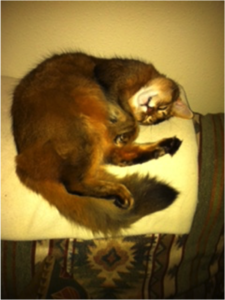
Opus wants you to check out my online nutritional certification course called Primal Restoration®. Click here for details.


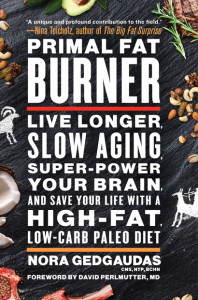
Nora, I feel inspired.Can you post the websites, where you order the supplements? Thank you for sharing the recipe. Opus is gorgeous and looks like a kitten!
This is awesome! I’ve been wanting to see a recipe like this for a long time. Is there one for dogs? And what do you think about bone meal or having bones ground in? I’ve seen this on other raw food recipes and I’ve seen bone meal in the primal raw food I feed my boy cat currently that does really well for him. Thanks!
Thanks. Well done!
Loved reading this entertaining article, Nora! So timely as I have been reading about feeding my dog raw food and was about to embark on research for my cat. Thank you! Do you have a recipe for dogs?
Bravo, excellent start! I’ve been feeding raw cats for over 40 years now. Some extra points to consider – beef heart is richest in taurine, and a better choice than synthetic taurine. Coincidentally mouse has highest levels of taurine! Cats require around 35% fat in their diet, so use fatty cuts. Chunks are better for dental health… I’ve never had to have a dental done on any of my cats or dogs. 10 – 15 % plant matter which feeds the gut biome, which in turn creates our immune system and is responsible for the stage of digestion in the upper small intestine. Gut biome consumes fermentable plant matter not meat/bones or fat. CALCIUM! As you are not feeding raw bones, dry egg shells and grind them in a coffee grinder add to your mix at 1/2 teaspoon per pound of meat.
Totally agree with u. My cat or dogs never go to the vet. My cat was almost dead, starting feeding Radcat, raw food and now he has a beautiful coat, flys around the house like a kitten. He’s 16 years old. My dogs are also raw fed, if they have any issues, they get essential oils to heal.
Thanks for the recipe.
Hi Nora
Thank you for sharing your rawsome kitty food recipe.
Opus has got to be one of the healthiest cats ever …. no need for a vet when kitty is cared for like Opus .
He is a beautiful cat and I can tell from his picture … he is a wise one.
Thanks for sharing 🙂
Chicken kidneys? Is that a misprint? I’ve never seen them for sale. From where do you get them?
I am on page 112 of “Primal Fat Burner,” and am enjoying it. I seem to be very resistant to weight loss and hope to overcome it with the aid of your book. I’m thinking that the reason is fat-bound toxins, but we’ll see.
I mainly credit you for my transition to LCHF since I heard you years ago on “Coast to Coast AM” promoting “Primal Body, Primal Mind” (I think that’s the name, I’ve mislaid my copy). Every year we seem to be closer to the ideal, but there is always room for improvement.
Dear Nora,
This is a wonderful story. And Opus is fantastic! I’d eat his food too.
I no longer have a pet, but am sharing this with friends that do.
I want to share with you something I made for my breakfast yesterday including 1 negligible piece of toasted rye bread.
Organ meats are something even many Paleo people fail to include in their diets, unawares that a little bit goes a long way in terms of nutritional density.
Look for it in my separate email.
OMG, laughed my butt off reading this! I know it was the crappy cat food that took my beloved cat nine years ago before I knew better. I find most clients feed their animals better than themselves and I often have to use their pets as the example of what they should be doing for themselves! Thanks for the laugh and the recipe.
Great article Nora, thank you. Your feline friend is very lucky to have you 😉
Could you use the same recipe for a dog, or what changes would you recommend making – composition and qty wise?
Have just finished your Primal Fat Burner book – loved it and enjoying cooking the recipes.
Cheers,
Daniel.
Sydney, AUS.
I forgot to mention in the recipe that I do periodically try to include a little organic bone meal in his recipe here and there. The butcher used to grind bones in for me but has since been prohibited from doing that (for some weird reason). In the back of my mind I was already aware of the higher taurine content of beef heart and will probably try to select for that next time I order his food. He has certainly gotten beef and lamb heart from time to time. But I will still add the extra taurine, regardless. Freezing the cat food tends to automatically lead to lower taurine levels and I prefer to err on the safe side. I do always use fatty cuts for him (hey—it’s ME), so he’s good there. I will, however disagree on one point: Cats and other carnivores do not require plant material to feed their microbiome. Collagen found in skin and bone, ligaments, tendons, cartilage and glucosamine/chondroitin (also known as glycosaminoglycans) all form a fermentable substrate for gastrointestinal bacteria. In fact, glucosamine/chondroitin are almost as fermentable a substrate as fructo-oligosaccharides (FOS)! This finding was actually confirmed in cheetahs— so cats definitely qualify. Here is at least one study:
Depeux S, Hesta M, Whitehouse-Ted K, et al. “Animal fibre: the forgotten nutrient in strict carnivores? First insights in the cheetah.” J Anim Physiol Anim Nutr (Berl). 2013 Feb; 97(1): 146-54
Cats are 100% carnivores and do not have any plant-based requirements whatsoever. Interestingly, neither do we (though we are better suited to consuming them than they are). Cats will eat grasses here and there, but typically vomit that back up later. It is thought that cats do this as a means of scouring for parasites. The tiny bit of green powder I give to Opus is mainly just there for the chlorophyll/odor control. I live in a small house and prefer to keep cat box odors to a minimum. I am happy to say that were Opus not as immediately social as he is when people come over no one would otherwise suspect we kept a cat in the house (based on any smell or furniture damage). He is even well behaved when it comes to only scratching on his scratching post. Our furniture is happily unmolested. Also, Somalis tend not to shed that much and also tend to be a bit more hypoallergenic than many other breeds, so that’s another plus for guests.
Thanks, though, for all your insight and suggestions! ~ Nora
We had a wonderful yellow lab. He was a year old and had a little diarrhea and wasn’t drinking. i had read that animals will do that in a healing crisis but I was vulnerable. I took him to the vet. She did an x-ray and said there might be something in his abdomen (he was a fourth generation raw fed dog from a breeder). She said I needed to take him to emergency as their clinic was closing for the night. I did that, and they did exploratory surgery to the tune of $5000. I don’ t mind spending money when it’s due but there was nothing there. I don’t imagine the surgery was very good for him. Thankfully he is still alive at 8 or so.
I actually wanted to thank you for this recipe. I’ve been wanting a recipe for my cat and knew of the work of Francis Pottenger so I was dedicated to raw. This is a blessing. Opus is gorgeous.
Excellent article.
Natural food, or food as natural as possible, is the best.
Try to teach your cat to catch mice. A mouse is eaten whole, including the partially digested plan matter in his guts. Contains bones/calcium and all he needs. A cat does not eat fresh vegetables but pre-digested fresh ones, like a mouse now and then is good.
It amazes me that butchers are prohibited to provide us with the best medicinal meat parts. Try to buy brain of cows or spleen for yourself, impossible in Europe. That is the way our health is diminished.
Hi,
Do you include raw bones in his diet because l thought cats in the wild eat the bones of their pray.
Cheers
I have 2 cats and 2 small dogs. 1 cat is part rag doll and the other part Persian. my 2 dogs are both Maltese. I have only fed them raw food shortly after I got them, mainly as I found them really fussy about the packaged dog and cat food available. Common sense shortly prevailed and my dogs only get raw food, minced meat, steak, liver and cats are only interested in tuna in spring water (human brand). Probably not as good as what you concoct but will start seeing what I can get for them and what they will like. The cats are really fussy and I can only get them to eat meat if I hand feed them mince or freshly baked chicken. Dogs love raw chicken drumsticks They are never sick and do not go to the vet, same as me to doctors.
I failed to mention that I do open up a capsule or two of Jarrow ‘Bone Up’ in each mixing bowl, which is a source of MCHA calcium from raw New Zealand bone, along with a few cofactors for healthy absorption. My bad for failing to mention it.
We have no mice in the house and Opus is a 100% indoor cat. He literally has zero interest in going outside, for which I am relieved. Although mice are technically a natural food for them, I would not be interested in having to worm him regularly (cats going outside and eating mice tend to end up with tapeworms…ewwww). Also, the plant matter from a mouse’s stomach is simply not a going concern for cats or other carnivores. No cat can have a plant-food deficiency. Connective tissue provides an ample fermentative substrate for any carnivore’s microbiome.
Thank you for your kind comments, Daniel!
I do think the same recipe would work well for dogs. A dog would probably not need the Taurine that I add to Opus’s formula, but the rest of it should work quite well. I failed to mention that I also empty a few MCHA (microcrystalline hydroxyapatite) capsules (Bone-Up, by Jarrow) into his recipe for the calcium/bone-based nutrients content.
Dear John,
Yes, in fact chickens DO have kidneys! My butcher mentioned it as an option one day when I was not able to get lamb kidneys for him.
Thanks so much for your kind words. I hope you will pick up another copy of Primal Body, Primal Mind sometime… It is still being sold widely on Amazon! Just make sure you get the 2011 edition. 🙂
As I said to one another person who asked the same question about dogs, I think the recipe I make for Opus would work just fine for dogs. I would just omit the added Taurine, is all. OH–and I failed to mention that I also empty a few MCHA (microcrystalline hydroxyapatite) capsules (Bone-Up, by Jarrow) into his recipe for the calcium/bone-based nutrients content.
Yes–I do think this recipe would work fine for dogs. I would just omit the taurine. I am not a huge fan of regular bone meal, as most of it comes from China and is frequently tainted with high levels of lead. The form of bone meal that opus gets (that I forgot to mention in my recipe) comes from New Zealand bovine sources and goes by the name of microcrystalline hydroxyapatite, or MCHA, for short. I add a few capsules of this into the recipe. Jarrow brand makes one called “Bone Up” that is widely sold on Amazon.
Nora…I love your passion and commitment to Opus! Plus everything else you do! I understand the desire to reproduce the best “urban” diet for our domestic friends, they rely on us almost solely for their health. I had started down the path to feeding my Australian Shepherd pooch a more natural organ meat and natural fat based diet, but I am inspired by your recipe. I enjoy preparing most of my own food, why not hers? I am still educating friends on how kibble just ruins the teeth of cats and dogs. Getting away from the well-accepted fallacy that hard kibble “cleans” their teeth! That’s like saying chomping on crunchy grain filled cereal is good for human dental health. E-gads!
Great read. Thank you!
Nora, love your research and wisdom. Question, I feed my dog raw but i thought it was more natural to give him raw chicken cut up “including the bone” this sorta ensures he has the correct bone to muscle and organ meat ration. any thoughts on why you don’t give Opus actual bones? I do find it to be a bit more messy at feeding time. thanks
Loved reading this story! I’ve been feeding my 3 dogs raw for the last 3 years. They are large dogs, 2 White German Shepherds, and 1 GS mix. Unfortunately they are all very sensitive to anything chicken, from chicken fat to eggs and everything in between, they just get explosive diarrhea if they happen to get even a trace of it. I used to rotate from chicken, beef, turkey and duck. Now Beef is out too. 🙁 Now they mostly get turkey, duck and lamb. When I give them liver they get diarrhea if given more then 1 tbsp, the female can have even less. They get kidneys and tripe too, but in very small amounts. It’s hard to find meat in chunks for them, mostly I get it ground with and without bone in. They love turkey necks, they can sink their teeth in and chew, and lamb necks. 🙂 I would love to feed them more of different things, I’m always on the lookout. I would not feed them any other way. Our Vet was not in favor of us feeding them raw, but I don’t care. We don’t often have to go there anyway, and they (roll their eyes when I come in) know now, that I do my own research and not only take their advice as gospel. 🙂
Finished reading your book “Primal Fat Burner” last night, and have some coconut yogurt in my yogurt maker as I type this. Thanks for this wonderful book!
Hi Nora,
Great timing. We just acquired an abandoned kitten (about 4 days old – eyes are not even open). I was wondering (I’ve only had dogs), do you think this would be an appropriate recipe for weaning our kitten off formula around 4 weeks old? It seems SO much better than any of wet kitten formulas on the market. Thank you! I’m going to get my dogs on this right away!
I forgot to add to the recipe 2 Capsules ‘Bone-Up’ Microcrystalline hydroxyappetite (MCHA) formula (a special type of bone meal with extra nutrient co-factors from clean, New Zealand bovine sources).
Thank you for this entertaining and informative post.
Opus is a gorgeous cat.
I have been thinking of transitioning our 2 cats to raw, but was not sure what a good recipe would be. Thankfully, I can now use yours.
Off to scour the city for a butcher who has pasture raised meats that can grind them up for me.
Nora, what a great written article. I just kept laughing and laughing. Opus is so beautiful and his bright eyes tell it all. You are so descriptive in your writing and very entertaining. My daughter loves cats and is begging us for one. I can not wait to share this article with her. Awesome article. Thank you Nora!!
I just wrote an article about my Ragdoll cat who eats Paleo, too. https://drdanenberg.com/cat-eats-paleo/
Hi, you have a beautiful, healthy cat! I’m wondering if, as time has moved on, you’ve checked out the multiple raw, carnivorous cat meals out there now in 2020? Or are you still doing your own?
Opus just celebrated his “Sweet 16” birthday the other day. He is still happy and healthy!
And yes… I am still making all his food for him. I tend not to trust others to do it for me. I have not yet seen one commercially prepared whose ingredient profile was entirely acceptable, and it’s far less expensive this way in any case.